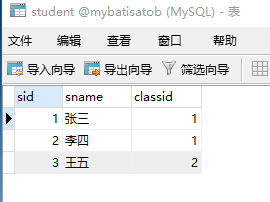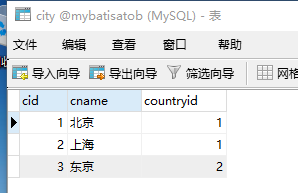代码下载
链接:https://pan.baidu.com/s/1FX4TmyKqZQx39ncn8TItfw 密码:1h1i
一对多(一个班级Class有多个学生Student)
前提:
1)所谓的一对多就是一方可以看见多方,至于多方是否能看见一方我们不管
2)对基本语法标签掌握,这里只对配置地方重点描述,别的地方不解释
3)把 数据库设计和类设计(在一方有一个多的集合)看懂了,很重要,很重要,很重要
数据库
数据库设计:一个班级有多个学生,在学生里有一个班级的外键classid


对应的实体类
Class实体类
package com.imooc.onetomany;
import java.util.ArrayList;
import java.util.List;
public class Class {
private Integer cid;
private String cname;
// 多方集合,即学生集合
private List<Student> students = new ArrayList<>();
//getter ,setter ,构造方法
}
Student实体类
package com.imooc.onetomany;
public class Student {
private Integer sid;
private String sname;
//getter,setter,构造方法
}
xxxMapper.java(dao层)
StudentMapper与之对应的xml
package com.imooc.onetomany;
public interface StudentMapper {
//根据ID查询学生
public Student selectStudent(Integer id);
//根据classID查询学生
public Student selectStudentByClassId(Integer classID);
}
<?xml version="1.0" encoding="UTF-8" ?>
<!DOCTYPE mapper PUBLIC "-//mybatis.org//DTD Mapper 3.0//EN" "http://mybatis.org/dtd/mybatis-3-mapper.dtd" >
<mapper namespace="com.imooc.onetomany.StudentMapper">
<resultMap id="BaseResultMap" type="com.imooc.onetomany.Student">
<id column="sid" property="sid" jdbcType="INTEGER" />
<result column="sname" property="sname" jdbcType="VARCHAR" />
</resultMap>
<select id="selectStudent" resultMap="BaseResultMap">
select sid,sname from student where sid = #{id}
</select>
<select id="selectStudentByClassId" resultMap="BaseResultMap">
select sid,sname from student where classid = #{id}
</select>
</mapper>ClassMapper与之对应的XML(敲黑板了,重点XML配置来了)
package com.imooc.onetomany;
public interface ClassMapper {
public Class selectClass(Integer id);
}
(重点重点重点在下面)
<?xml version="1.0" encoding="UTF-8" ?>
<!DOCTYPE mapper PUBLIC "-//mybatis.org//DTD Mapper 3.0//EN" "http://mybatis.org/dtd/mybatis-3-mapper.dtd" >
<mapper namespace="com.imooc.onetomany.ClassMapper">
<resultMap id="BaseResultMap" type="com.imooc.onetomany.Class">
<id column="cid" property="cid" jdbcType="INTEGER" />
<result column="cname" property="cname" jdbcType="VARCHAR" />
<collection property="students" ofType="com.imooc.onetomany.Student"
column="cid" select="com.imooc.onetomany.StudentMapper.selectStudentByClassId"></collection>
</resultMap>
<select id="selectClass" resultMap="BaseResultMap">
select cid,cname from class
where cid = #{id}
</select>
</mapper>1 ) 在reslutMap中用collection标签
2 ) property属性对应一方(Class)里面的属性List<Student> students
3 )ofType对应 对应多方的数据类型,注意写全类名
4) select 属性是调用哪个接口里的哪个方法,此文章中是调用com.imooc.onetomany包下的StudentMapper类的selectStudentByClassId方法
5)column 属性是向 select属性的接口传递的参数
多对一(多个城市City对应一个国家Country)
前提:
1)所谓的多对一就是多的一方可以看见一的一方,一的一方能不能看见多方我们不管
2)对基本语法标签掌握,这里只对配置地方重点描述,别的地方不解释
3)把 数据库设计和类设计(在多的一方有一个一的属性)看懂了,很重要,很重要,很重要
数据库设计
数据库解释:在多的一方有一个一的外键


实体类
City多方
package com.imooc.manytoone;
public class City {
private Integer cid;
private String cname;
//添加一个一方的属性
private Country country;
//getter setter 构造方法
}
Country一方
package com.imooc.manytoone;
public class Country {
private Integer id;
private String name;
//getter setter 构造方法
}
xxxMapper.java(dao层)
CityMapper与之对应的xml(敲黑板,重点来了)
package com.imooc.manytoone;
public interface CityMapper {
public City selectCity(Integer id);
}
<?xml version="1.0" encoding="UTF-8" ?>
<!DOCTYPE mapper PUBLIC "-//mybatis.org//DTD Mapper 3.0//EN" "http://mybatis.org/dtd/mybatis-3-mapper.dtd" >
<mapper namespace="com.imooc.manytoone.CityMapper">
<resultMap id="BaseResultMap" type="com.imooc.manytoone.City">
<id column="cid" property="cid" jdbcType="INTEGER" />
<result column="cname" property="cname" jdbcType="VARCHAR" />
<association property="country" javaType="com.imooc.manytoone.Country"
select="com.imooc.manytoone.CountryMapper.selectCountry" column="countryid"></association>
</resultMap>
<select id="selectCity" resultMap="BaseResultMap">
select cid,cname,countryid
from city
where cid = #{id}
</select>
</mapper>1) resultMap中用association标签
2)property属性是多方里的一方的属性 ,即City类里的country属性
3)javaType是你一方的类型
4)column是传给select属性里面的方法的参数
5)select属性是调用哪个方法
CountryMapper与之对应的xml
package com.imooc.manytoone;
public interface CountryMapper {
public Country selectCountry(Integer id);
}
<?xml version="1.0" encoding="UTF-8" ?>
<!DOCTYPE mapper PUBLIC "-//mybatis.org//DTD Mapper 3.0//EN" "http://mybatis.org/dtd/mybatis-3-mapper.dtd" >
<mapper namespace="com.imooc.manytoone.CountryMapper">
<resultMap id="BaseResultMap" type="com.imooc.manytoone.Country">
<id column="id" property="id" jdbcType="INTEGER" />
<result column="name" property="name" jdbcType="VARCHAR" />
</resultMap>
<select id="selectCountry" resultMap="BaseResultMap">
select id,name from country
where id = #{id}
</select>
</mapper>一对一
类似多对一,多的一方剩下一个就是一对一
多对多
这个地方写的不好,建议读
数据库:3张表,一张关系表,都懂哈
我也百度了一些博客,总的思路就是:多个一对多就是多对多
这里没有什么标签,就是两个步骤:
1 修改xxxMapper.xml中的resultMap
2 在select标签中写SQL语句(多表查询的语句,没巧方法), select xxx from table1,table2,table3 where 巴拉巴拉,注意与resultMap中对应